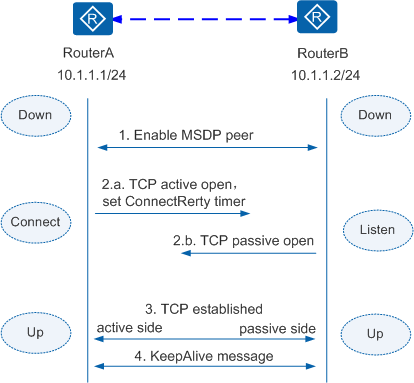MSDP Peer Setup
Setting Up MSDP Peer Relationships
MSDP peers use port 639 to set up TCP connections.
After MSDP is enabled on two devices and they are specified as MSDP peers, the devices compare their IP addresses. The device with a smaller IP address starts the ConnectRetry timer and initiates a TCP connection to the other device. The device with a larger IP address monitors whether a TCP connection is set up on the port 639. The MSDP peer relationship is set up after a TCP connection is set up. MSDP peers maintain the TCP connection by exchanging Keepalive messages.
As shown in Figure 1, an MSDP peer relationship is set up between RouterA and RouterB as follows:
- In initial state, the MSDP session is Down on the two routers.
- After MSDP is enabled and the routers are specified as MSDP peers to each other, the routers compare their IP addresses used to set up a TCP connection.
- RouterA has a smaller IP address. Therefore, it enters the Connect state, initiates a TCP connection to RouterB, and starts the ConnectRetry timer. This timer determines the interval for retrying TCP connection setup.
- RouterB has a larger IP address. Therefore, it enters the Listen state and waits for a connection setup request from the peer.
- After a TCP connection is set up, the MSDP session becomes Up.
- The MSDP peers send Keepalive messages to request each other to maintain the MSDP session status.
MSDP Authentication
To improve MSDP security, MSDP peers perform TCP connection authentication. You must configure the same encryption algorithm and password on the two ends. Otherwise, the TCP connection cannot be set up between MSDP peers. MSDP supports two encryption modes: MD5 and Keychain. The two modes are mutually exclusive, and you can configure only one of them between MSDP peers.
